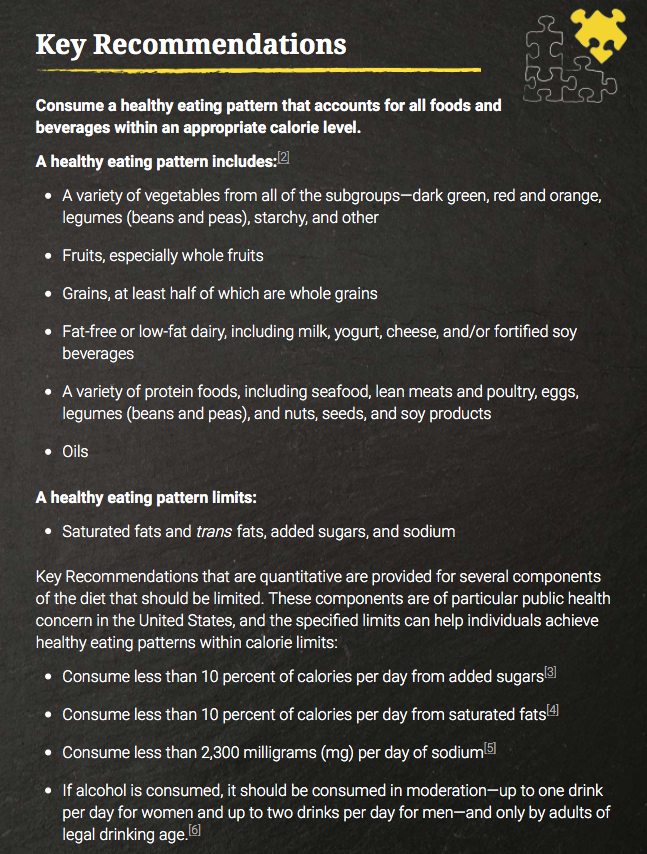Move over Star Wars and iPhones – this is the line for the Dietary Guidelines! Every 5 years, the government gives us their OFFICIAL recommendation for what constitutes the ideal dietary plan for health. In a world of food politics, conflicting studies, and warring mealtime paradigms, this moment of proclamation sets the definite tone for half a decade to come. So without further ado, here are my thoughts on the new 2015 Dietary Guidelines, released, of course, in 2016.
THE BASICS
The 2015 dietary guidelines basically tell us to eat from the 5 food groups of fruit, vegetables, grains, meat, and dairy, while limiting the 3 basic components of sugar, saturated fats, and sodium.

THE GOOD
- I love the spirit of the guidelines as laid out in the introduction: “Today, about half of all American adults—117 million people—have one or more preventable, chronic diseases, many of which are related to poor quality eating patterns and physical inactivity.” I’m so down with this, as I believe diet is both the foundation of health, as well as a potential gateway to chronic disease. And while I don’t think you must mercilessly sweat it out at a gym for optimum health, sedentary lifestyles are definitely detrimental and part of the problem.
- I like the focus on whole foods: “Nutritional needs should be met primarily from foods. Individuals should aim to meet their nutrient needs through healthy eating patterns that include nutrient-dense foods. Foods in nutrient-dense forms contain essential vitamins and minerals and also dietary fiber and other naturally occurring substances that may have positive health effects.”
- The guidelines have (finally!) changed their opinion on dietary cholesterol, previously limited to 300mg per day, which is about 2 eggs’ worth. This is refreshing, since the demonization of dietary cholesterol (especially nutrient-rich egg yolks) was paired with the demonization of dietary fat.
- As an intermittent faster, I’m almost giddy the guidelines have abandoned a breakfast push. While the previous 2010 guidelines noted that breakfast “has been associated with weight loss and weight loss maintenance, as well as improved nutrient intake,” and that skipping breakfast “has been associated with excess body weight, especially among children and adolescents,” this is gone from the 2015 version. Good riddance.
- There is less emphasis on calories than previous guidelines.
- The guidelines discourage excess sugar, saying to consume less than 10 percent of calories per day from such.
- The guidelines discourage excess sodium, advocating less than 2,300 milligrams per day. In my opinion, sodium is basically an euphemism for processed foods, which I’m ALL for limiting. (It’s quite difficult to over consume sodium on a non-processed, whole foods diet.) I also admit this is a double standard, since I don’t like the guideline’s recommendations to consume less “saturated fat,” which is likely an euphemism for meat. See “The Bad” below.
- The guidelines make healthy recommendations for fruit, encouraging whole fruit over fruit juices. The guidelines also note that juices should be 100% juice without added sugar, canned fruit should be low in added sugar, and dried fruit is also discouraged.
- As the author of The What When WINE Diet, I’m happy the guidelines allow for alcohol in moderation- one drink for women per day, and two for men. (Though I probaby go over that – oops.)
- The guidelines support moderate coffee intake. Though I don’t drink coffee myself anymore these days, I’m happy it’s got the green light, especially for all you BulletProof coffee fasters out there!
- I like the guideline’s approach to physical activity, which emphasizes avoiding sedentary lifestyles and switching to a more active lifestyle approach. As noted in the guidelines, “Most individuals would benefit from making shifts to increase the amount of physical activity they engage in each week. Individuals would also benefit from limiting screen time and decreasing the amount of time spent being sedentary.”
THE BAD
- The guidelines continue to demonize saturated fat, limiting it to 10% of one’s daily calories. (For reference, a steak contains typically around 20%-30% saturated fat.) Now saturated fat is a tricky topic. In a healthy, whole foods lifestyle devoid of processed foods and insulin-spiking sugar, saturated fat is awesome, supplying nutrients, building blocks for cell membranes, and long-burning energy. But in the context of our modern, processed diets in which sugar becomes the main source of fuel, saturated fat can adopt a potentially inflammatory nature, since it basically serves as mere excess and easily stored calories in the presence of sugar. The 2015 guidelines don’t acknowledge this complicated relationship, and instead take a very black and white approach to saturated fat – it is bad and should be limited. This reaffirms the fat-phobic zeitgeist which I honestly believe has encouraged the obesity epidemic in the first place (by sacrificing nutritious meats and whole foods for high sugar, processed frankenfoods.) Saturated fat also implies meat in the mind of most Americans, so by limiting saturated fat, the guidelines are insinuating to limit meat consumption. For the Paleo peops among us who often embrace meat as the foundation of a strong, healthy body, this is a smidge problematic.
- The guidelines continue to prescribe grains. While we’ve progressed from the food pyramid based entirely on grains {shudder}, the guidelines nevertheless continue to encourage a food group which is insanely inflammatory, insulin-spiking, and even downright deadly for some people, like those with Celiac disease. Yes, grains provide energy, but they also provide a foundation for chronic disease in the meanwhile. Check out my posts on gluten, lectins, and other grainy problems. That being said, I do sense a slight hesitancy in the guideline’s support of grains, almost in a we know we shouldn’t be saying this but here’s why we can justify it type way: “Within this body of evidence, higher intakes of vegetables and fruits consistently have been identified as characteristics of healthy eating patterns; whole grains have been identified as well, although with slightly less consistency.”
- The guidelines recommend consuming other inflammatory foods such as soy products and legumes. While these foods may have individual advantages in a cost/benefit view, they are often inflammatory and detrimental to health. The guidelines also encourage low fat dairy, yet it is the proteins (casein, whey) and sugars (lactose) in dairy which provide the inflammatory and allergenic problems in the first place. This is why the Paleo approach recommends super high fat versions of dairy, such as ghee and grass-fed butter, which minimize problematic responses while providing a slew of healthy fatty acids and nutrients.
- Some healthy immune-boosting oils, like coconut and palm, are discouraged (due to their saturated fat content) while inflammatory plant oils like canola are actually encouraged.
- Finally, there is no mention of gluten in the guidelines. Zilch. I find this kind of shocking. The gluten issue has arguably spread from the holistic fringe to the mainstream (at the expense of receiving a misleading “fad” label), and there are a myriad of scientific studies to support gluten’s inflammatory and disease-promoting nature. All I want is just one sentence in the grains section, saying grains might be problematic due to their gluten content. {Sigh}

THE MURKY
- The guidelines are highly political in nature. Just consider that they’re issued in part by the U.S. Departments of Agriculture. As pointed out in the 1/8/2016 TIME article, “Experts Say Lobbing Skewed the U.S. Dietary Guidelines”: Many also contend the USDA should not play a primary role in shaping America’s dietary policies. [Dr. Robert Lustig, a pediatric endocrinologist at the University of California} says tasking the government agency that manages America’s food production with crafting nutrition policy is akin to ‘putting the fox in charge of the hen house.’ Placing the guidelines solely in the hands of the Department of Health and Human Services would be a step in the right direction, [Dr. Walter Willett, chair of the Department of Nutrition at Harvard School of Public Health] says. Furthermore, the guidelines aren’t even aimed towards you and me, but rather the people who decide what you and me should do. While at one point the guidelines state they are trying to “help Americans choose a healthy eating pattern and enjoyable diet,” in the next, they note the primary audience is “policymakers, as well as nutrition and health professionals, not the general public.” In other words, the powers that be aren’t so confident that you can make your own decisions for your own health – you need someone to tell you what to do. And when these people are intrinsically tied to industries with conflicting interests, one cannot help but wonder what truth is sacrificed at the expense of a dollar.
- As discussed above, the guidelines spotlight limiting “sugar,” “sodium” and “saturated fat.” These are arguably euphemisms for processed foods and meat. I agree with limiting the former (processed foods), but not the later (meat). Regardless, using such terminology insinuates politics involved in the guidelines. Appeasing the powerful processed foods and meat industries leads to this vague terminology, calling into question the objective interpretations of scientific findings regarding health and nutrition.
- Though the guidelines note that, “there are many ways to consume a healthy eating pattern, and the evidence to support multiple approaches has expanded over time,” they specifically accommodate two, and only two, “outlier” dietary approaches: The Mediterranean Diet and Vegetarianism. The guidelines provide specific guides for following such diets. Although they give, what I assume to be, a vague nod to a lower carb approaches by saying that “healthy eating patterns can be flexible with respect to the intake of carbohydrate, protein, and fat within the context of the AMDR [Acceptable Macronutrient Distribution Range],” I find it disappointing that a low carb or Paleo approach isn’t mentioned. {Sigh.}
- Despite adamant appeals for inclusion, the guidelines do not include anything about sustainability. More on that later!
THE TAKEAWAY
This might seem crazy, but I’m sort of happy with the guidelines, given where they’re coming from. There’s such resistant to the holistic food health movement from the industrial food and agriculture industries, that it’s a wonder we’ve come this far! That being said, you could follow many different dietary approaches which would fit the criteria of the 2015 guidelines and, depending on your personal constitution, face wonderful or detrimental health from such.
And therein lies the problem.
The dietary guidelines focus on a vague, inclusive sense of what to eat, rather than what to not eat. I believe the majority of chronic illnesses we face today come from what we are eating. The Paleo mindset sees the problem from what we’ve ADDED – the overwhelming intake of processed foods, grains, and sugar. If you cut out all the crap, you almost don’t even need guidelines. If everyone simply cut out grains, sugar, and processed foods, it could possibly revolutionize the health of the population at large. And that takes only one sentence to say! The guidelines also recommend consuming foods which can be downright detrimental to health, like grains and soy, as well as other potentially inflammatory foods like dairy. This is almost inexcusable in my opinion.
The 2015 Dietary Guidelines read like a good novel. They’ve got a nice, encouraging, “accommodating” whole foods spirit of moderation, but the subtext screams political pacifying tension. The claim they are “grounded in the most current scientific evidence,” but I’m not so sure what was sacrificed in the process of protecting the dollar. Still, we’ve come a long way, and I have high hopes for the future of the holistic health movement.


